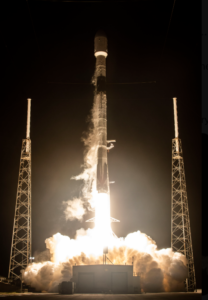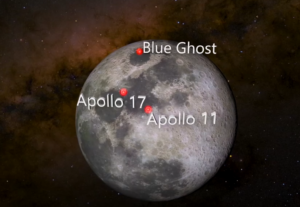American, Japanese Landers on the Way to the Moon
Two lunar landers, one American and one Japanese, are on their way to the Moon this morning. The two are unrelated except for sharing a ride on SpaceX’s Falcon 9 and are taking different routes to their lunar destinations. Blue Ghost Mission 1, built by the U.S. company Firefly, will land on March 2. The SMBC x HAKUTO-R Venture Moon lander/rover, built by Japan’s ispace, will take longer, arriving at the end of May or early June.
The two lifted off from Kennedy Space Center’s Launch Complex 39A at 1:11:39 am ET. Blue Ghost separated from the rocket’s second stage 1 hour and 5 minutes after launch and Venture Moon 27 minutes later.

Blue Ghost is part of NASA’s Commercial Lunar Payload Services (CLPS) initiative where NASA purchases lunar delivery services to put payloads on the Moon from commercial companies instead of building their own spacecraft. The companies design, build and launch the spacecraft and are expected to find non-NASA customers to close their business cases. NASA is paying Firefly $101 million for this mission and spent another $44 million on its 10 payloads.
This is Firefly’s first attempt at a Moon landing, but NASA’s third CLPS mission. Astrobotic’s Peregrine and Intuitive Machines’ Odysseus launched last year. Peregrine suffered a propulsion failure and never reached the Moon. Odysseus landed, becoming the first U.S. spacecraft to land on the Moon since Apollo 17 in 1972, but tipped over on its side. Both were able to return scientific data, however, and are considered successes by NASA and the companies.
Firefly is hoping to do them one better, nailing the landing and collecting data with the 10 NASA payloads onboard, the most NASA has put on any CLPS lander so far. Blue Ghost will take 45 days to get to the Moon, spending 25 days in Earth orbit, 4 days in lunar transit, and 16 days in lunar orbit before descending and landing on March 2. Once there, it’s intended to function for one lunar day, which is 14 Earth days. Some are saying this will be the first commercial soft lunar landing, but others might count IM’s Odysseus as the first even though it wasn’t completely upright.

Blue Ghost is one of a new class of small lunar landers that are less expensive, but also less robust. Powered only by solar cells, not radioisotope power sources, they are not expected to survive the lunar night when sunlight disappears for 14 days and temperatures fall to -250°C (-418°F). This spacecraft is 2 meters (6.6 feet) tall and 3.5 meters (11.5 feet) in diameter.

The 10 NASA payloads are:
- Next Generation Lunar Retroreflector (NGLR)
- Radiation Tolerant Computer System (RadPC)
- Regolith Adherence Characterization (RAC)
- Lunar Magnetotelluric Sounder (LMS)
- Lunar Environment Heliospheric X-Ray Imager (LEXI)
- Lunar PlanetVac (LPV)
- Lunar Instrumentation for Subsurface Thermal Exploration with Rapidity (LISTER)
- Stereo Cameras for Lunar Plume-Surface Studies (SCALPSS) 1.1
- Electrodynamic Dust Shield (EDS)
- Lunar GNSS Receiver Experiment (LuGRE)

Understanding more about lunar dust is one of the mission’s main objectives. “Regolith adherence” is a problem because the sticky dust can interfere with the operation of spacesuits and mechanical equipment. Three instruments — RAC, EDS, and LPV — will study how it adheres to various materials and whether electromagnetism can be used to prevent it from sticking. NASA also is sending the LISTER drill that will take measurements of the Moon’s internal heat flow 2-3 meters (6.5-10 feet) below the surface.
Blue Ghost will land in the Mare Crisium basin near a volcanic feature called Mons Latrielle, a site chosen specifically for this mission because of those experiments. During a pre-launch science briefing yesterday, NASA’s Maria Banks explained the site avoids magnetic anomalies that could disrupt the electromagnetism experiment, as well as subsurface rocks that could affect drilling operations.
NASA has several more CLPS missions in the works and expects at least one more this year. Intuitive Machines’ second mission is scheduled to lift off next month. Others also are possible, although NASA stresses these are not NASA missions so they do not set the launch dates, it’s up to the companies and their launch service providers. During a pre-launch briefing yesterday, Nicky Fox, head of NASA’s Science Mission Directorate that oversees the CLPS program, said they have 13 companies that are eligible for CLPS contracts. So far, five of them have been awarded a total of 11 deliveries to send more than 50 NASA instruments to the Moon. The cumulative maxmum contract value is $2.6 billion through 2028.
Other countries and companies also are launching these new small lunar landers. Tonight’s launch of SMBC x HAKUTO-R Venture Moon is ispace’s second attempt. Their first mission, HAKUTO-R M1, in 2023 failed in the very last moments before landing due to a software error. (HAKUTO is White Rabbit in Japanese.) ispace CEO Takeshi Hakamada said at a pre-launch briefing on January 8 (EST) that failure is a way to learn and move forward and with this mission they hope to “convey to everyone across Japan the importance of perseverance and embracing challenges.” They launched a domestic promotion campaign entitled “let’s ensure Japan does not become a nation where failure is not an option.” The company’s motto is “Never Quit the Lunar Quest.”

SMBC x HAKUTO-R Venture Moon, supported by Sumitomo Mitsui Banking Corporation (SMBC), includes the RESILIENCE lander and the TENACIOUS micro-rover, developed by ispace’s European subsidiary, ispace-Europe. TENACIOUS will collect lunar samples under a mission authorization license from Luxembourg and ownership of the samples (not the samples themselves) will be transferred to NASA under a 2020 contract. TENACIOUS has a forward-mounted HD camera and a shovel.
TENACIOUS weighs just 5 kilograms (11 pounds) and is 26 centimeters (10 inches) tall, 31.5 cm (12.4 inches) wide, and 54 cm (21 inches) long.
In addition to TENACIOUS, the spacecraft is delivering five payloads for commercial customers.
- Water electrolyzer equipment: From Takasago Thermal Engineering Co.
- Food production experiment: A self-contained module from Euglena Co.
- Deep space radiation probe: Developed by the Department of Space Science and Engineering, National Central University, Taiwan
- Commemorative alloy plate: Developed by Bandai Namco Research Institute, Inc. and modeled after “Charter of the Universal Century” from the animation Mobile Suit Gundam UC
- Moonhouse: A model house by Swedish artist Mikael Genberg that will be mounted on the rover.
The lander, 2.5 meters (8 feet) wide and 2.3 meters (7.5 feet) high, also has a UNESCO memory disk that preserves linguistic and cultural diversity.
The spacecraft will be taking a longer trajectory to the Moon than Blue Ghost. The exact arrival date will be determined later, but Hakamada said it will be in the late May-early June time frame. The landing site is near the center of Mare Frigoris (Sea of Cold) at 60.5 degrees north, 4.6 degrees west.

Although ispace’s first lander failed, Japan did successfully land on the Moon last year. That mission, the Small Lander Investigating Moon (SLIM), was built by the Japan Aerospace Exploration Agency (JAXA). SLIM landed upside down due to an engine failure, but had a very successful mission overall and surprised everyone by surviving the lunar night more than once.
This article has been updated.
User Comments
SpacePolicyOnline.com has the right (but not the obligation) to monitor the comments and to remove any materials it deems inappropriate. We do not post comments that include links to other websites since we have no control over that content nor can we verify the security of such links.